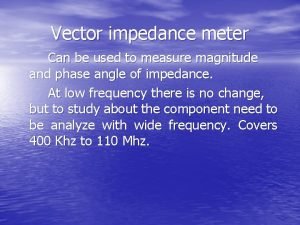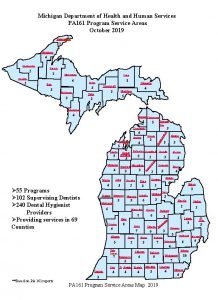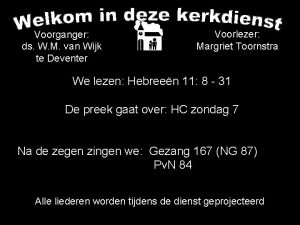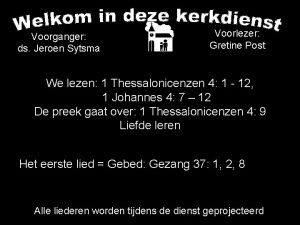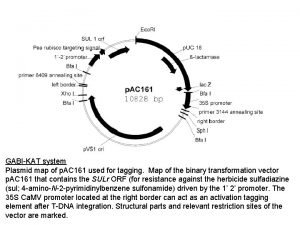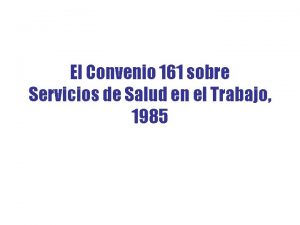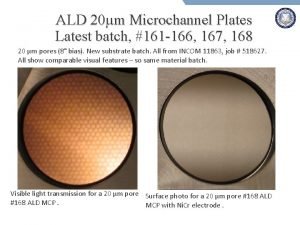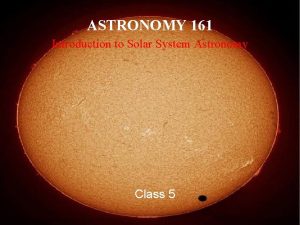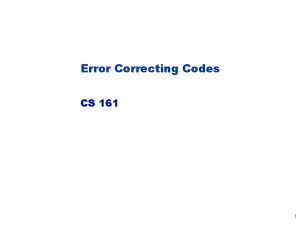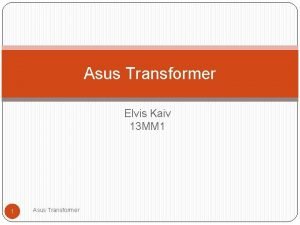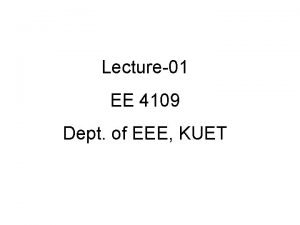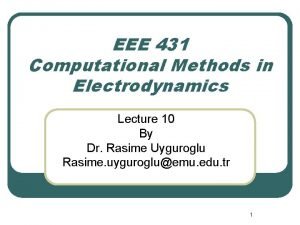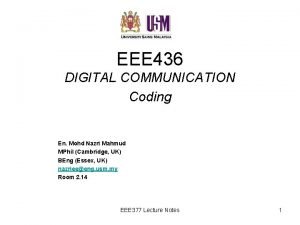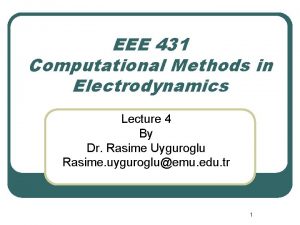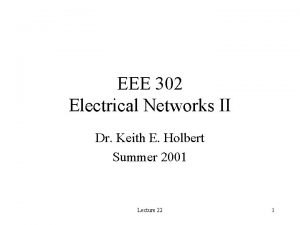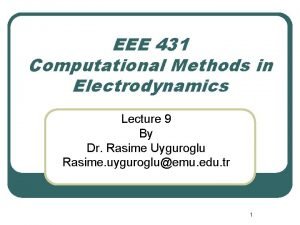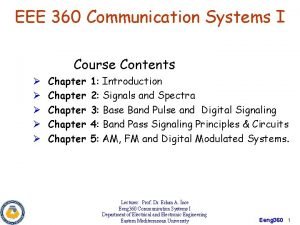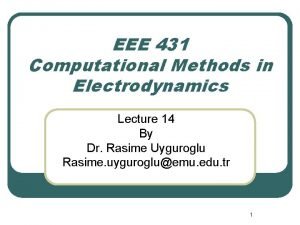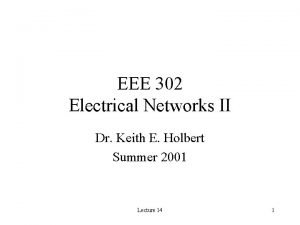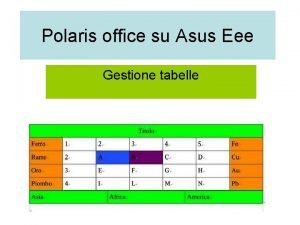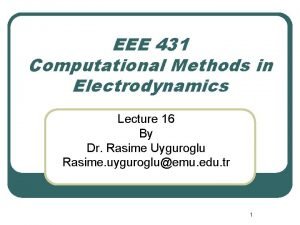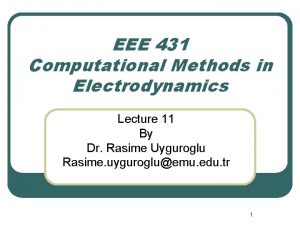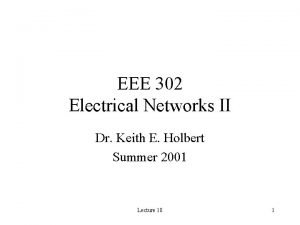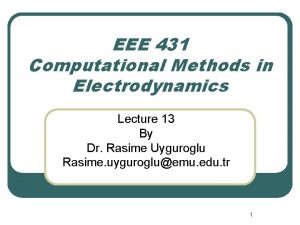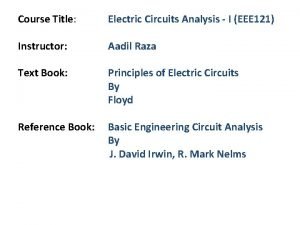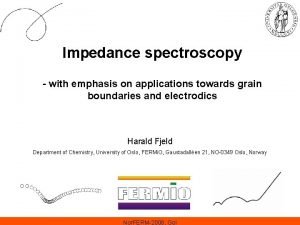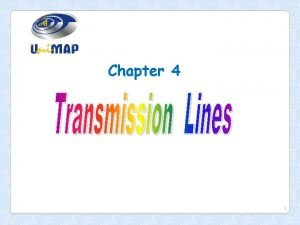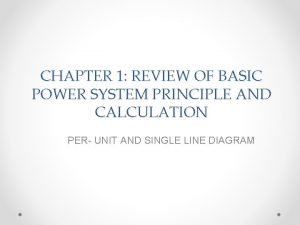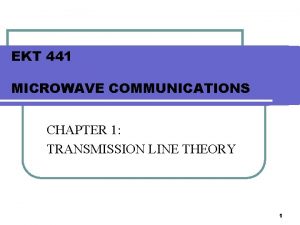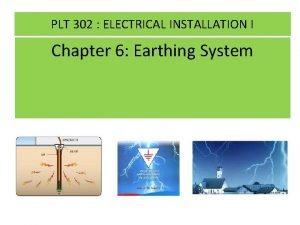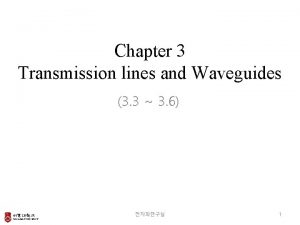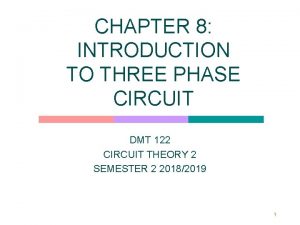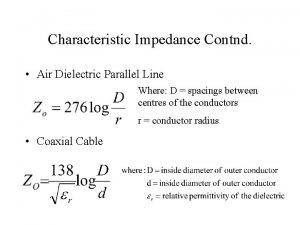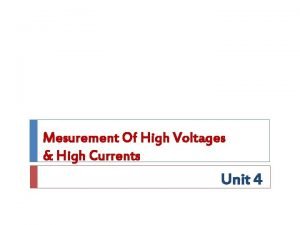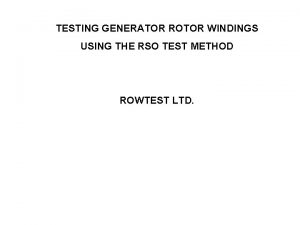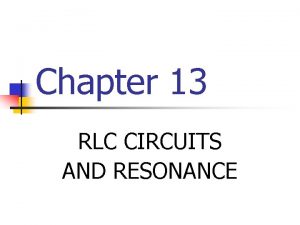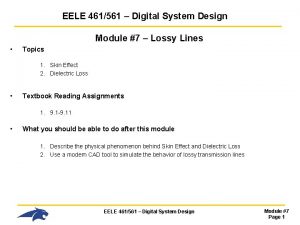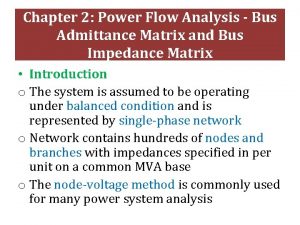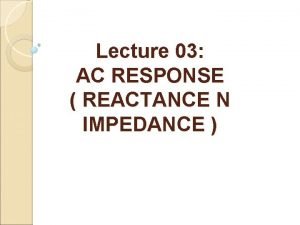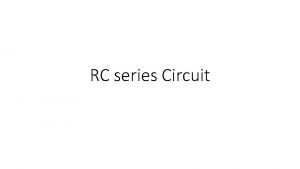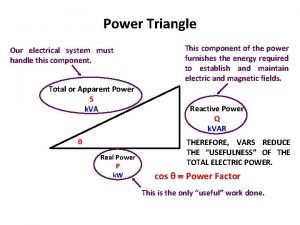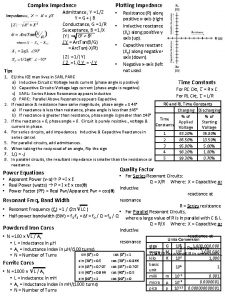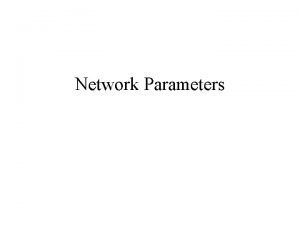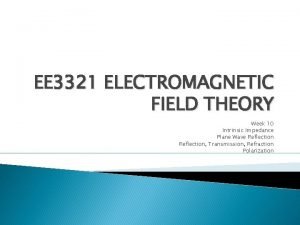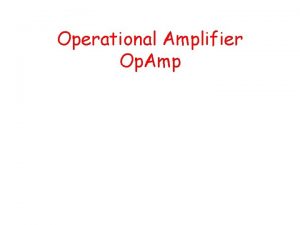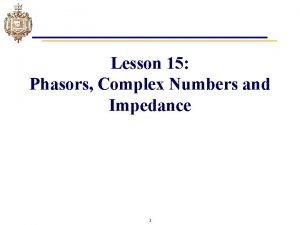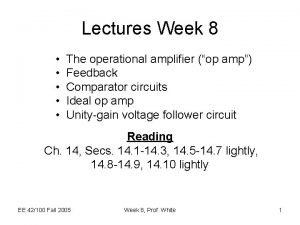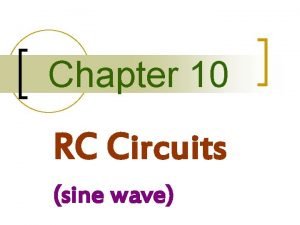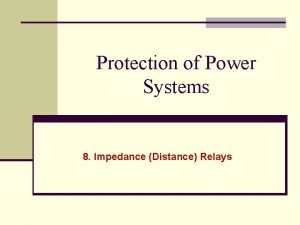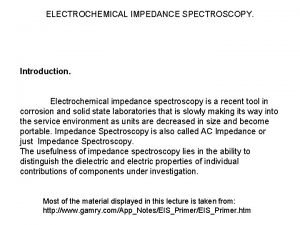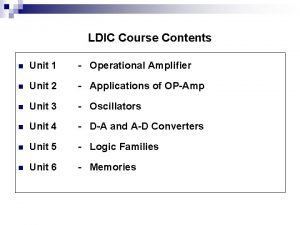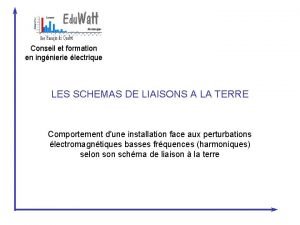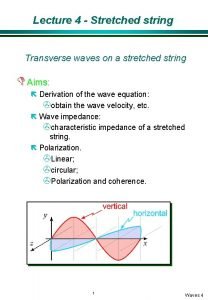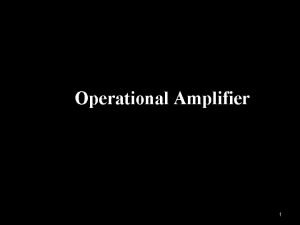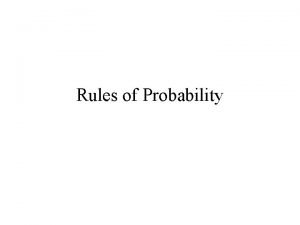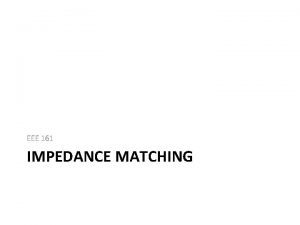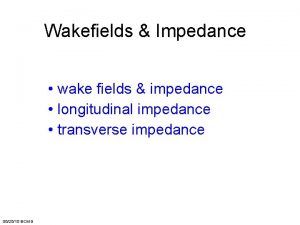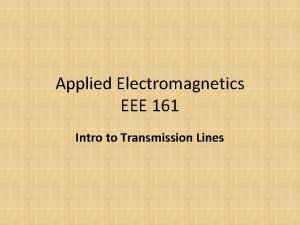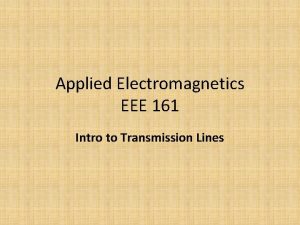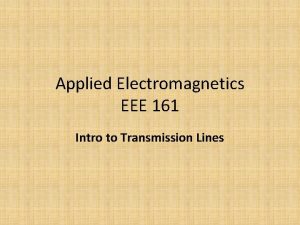EEE 161 IMPEDANCE MATCHING Recall What do we

























































































































- Slides: 121

EEE 161 IMPEDANCE MATCHING

Recall • What do we know about Power?


Objective • Students will be able to – explain why is the impedance matching needed – How real power changes from the input to the output of a lossless transmission line – What is the requirement for maximum available power from the generator? – What is the requirement for the minimum reflected power from the load?

Why do we look at power transfer at RF? • At lower frequencies we look at voltage gain or current gain • At Radio Frequencies (RF) we look at the power transfer • At low frequencies the voltage at one end of a cable is the same as the voltage at the other side of the cable • At RF the voltage at the input of the cable is not the same as the voltage at the output, BUT: the delivered power at the input port is the same as the power delivered to the load (no power is dissipated in reactive elements)

Wave propagation on a TL

Impedance matching • We need to maximize power transfer between source and the load • Maximum power transfer occurs when the impedance of the load and the generator are complex conjugate of each other. • This maximizes V

Instantaneous Power Flow

Average Power

Conjugate match maximizes ZL=Zo Minimizes reflection


Incident, Reflected and Delivered Power • Seemingly, we have two requirements: • 1) • 2) For maximum power transfer To minimize reflected power What is the input impedance Zin=? if ZL=Zo? Look at the Smith Chart. Where is ZL (normalized)?

Incident, Reflected and Absorbed Power • Seemingly, we have two requirements: • 1) • 2) Maximizes Minimizes Available power from the generator • When Zl=Zo, and Zg=Zo, then we have the best of both worlds!

Graded Quiz IM#1 A transmitter operated at 20 MHz, Vg=100 V with 50Ω internal impedance is connected to an antenna load through 6. 33 m of the line. The line is a lossless 50Ω, β=0. 595 rad/m. The antenna impedance at 20 MHz measures ZL=36+j 20 Ω. a) What is the electrical length of the line? (length=0. 6 λ ) b) How much power is delivered to the line? Hint: Find the input impedance, then Pav, in=1/2 Re{V (I )*}=1/2 Re{Z I (I )*}=1/2 R *|I |^2 c) What is the time-average power absorbed by Z ? P =1/2 R * |I |^2 d) If Z is matched to 50 Ohm line, what is the input impedance of the line, and how much average power is delivered to the line and load? in in in l l l in l l




At the load z=0

Answers Note that the “real” power at the load and the “real” power at the generator are the same.


(cont. ) Cont.

(cont. )

Why are we doing impedance matching? MAXIMUM POWER TRANSFER







SIMPLEST IMPEDANCE MATCHING CASE

Objective • Students will be able to – Design a lumped element impedance matching network for the load impedance Z=1+j. X or Z=1 -j. X (removing reactance only)

Guided Exercise • The load impedance is given ZL=50+j 50. Find the impedance matching network to match this impedance to 50 Ohm generator.

First Normalize the Impedance • 50 Ohm Generator (or transmission line)

Which circle would you use to go to the center “Game” move the Zl to the center of the Smith Chart using only circles that are centered on the x-axis. Why? Because we only want to add reactances or susceptances to ZL.






Independent Exercise • Find the impedance matching network to match impedance ZL=50 -j 100 Ω to 50Ω generator. • Describe how is the load impedance transformed using Smith Chart • Sketch the circuit: load impedance, the impedance matching circuit and the generator



Motivation • What if we have to match a dipole antenna to 50 Ω line? • How is this impedance different than the previous one?

Motivation • This impedance does not have the real part equal to 50 Ω. • We have to transform real and imaginary parts!

MIXED IMPEDANCE MATCHING NETWORK

Objective • Students will be able to – Design a mixed transmission line and lumped element impedance matching network for any load impedance

Mixed impedance matching network • Add a line to the load so that the – impedance at the input of the line is Zin=1+j. X or 1 -j. X (make the resistance = 50 Ohms) – OR admittance at the input of the line is Yin=1+j. B or 1 -j. B (make the conductance 1/50 Si. ) • Then add a lumped element in series or parallel to remove the reactive part of the impedance

Guided Example • Using Smith Chart Design TWO different mixed impedance matching networks to match ZL=25+j 50 Ω impedance to a 50 -Ω line.

Where all the points on the Smith Chart where the input impedance can be =1 or input admittance can be =1 Where all the points on the Smith Chart where THIS TL can have real part of input impedance or admittance =1. How long should the line be so that the real part of the input impedance is equal to 50 (norm. 1)?


Now add the reactance in series or parallel to cancel the reactive impedance at the input of the transmission line!

Now add the reactance in series or parallel to cancel the reactive impedance at the input of the transmission line!

What are we trying to do?

Guided Example • Using Smith Chart Design TWO different mixed impedance matching networks to match ZL=25+j 50 Ω impedance to a 50 -Ω line.


Solution 1

Solution 1 on Smith Chart

Solution 1 on Smith Chart

Solution 1 on Smith Chart

Solution 1 on Smith Chart Read the reference position (0. 135 λ) WTG Read the input impedance position (0. 425 λ) WTG





Solution 2


Graded Quiz IM#2 • Using Smith Chart design two mixed impedance matching networks to match a half -wave dipole with input impedance ZL=74+j 42. 5 Ω to a 50 -Ω line. • One should consider R=1 and the other G=1 Jargon alert: I say “input impedance of the dipole”, because I am looking into the dipole, and its impedance is the load impedance to the transmission line.











TRANSMISSION LINE IMPEDANCE MATCHING CIRCUIT

Transmission Line Impedance Matching Circuit • Add a line to the load so that the – input impedance of the line is 1+j. X or 1 -j. X – OR input admittance of the line is 1+j. B or 1 -j. B • Add a stub to remove reactive impedance j. X or JB

What is a stub? • Stubs are transmission lines with short circuit or open circuit loads • Input impedance will be reactive

Find the input impedance of a open line l=0. 125λ

Find the input impedance of What a will happen if the line is a open line l=0. 125λ little shorter/longer, longer than 0. 25

General statement about input impedance?


Guided/Independent Exercise (IM#3 prep) • Using Smith Chart design two transmission line impedance matching networks to match a half-wave dipole with input impedance ZL=74+j 42. 5 Ohms to a 50 -Ohm line. • Hint: Just replace lumped elements with stubs




How do we design the stub to look like inductor of Z=j 0. 8?




Graded Quiz IM#3 • Use the solution of IM#2 to make two purely transmission line impedance matching circuits. { Hint: In your IM#2 replace the lumped element with a shorted or open stub. }

• Why only transmission lines • Pictures of lumped elements





LUMPED ELEMENT IMPEDANCE MATCHING CIRCUIT

Objective • Students will be able to – Design a lumped element impedance matching network for any load impedance

Lumped Element matching network • Add an element in series or parallel to ZL so that the – impedance at the input of the line is Zin=1+j. X or 1 -j. X (make the resistance = 50 Ohms) – OR admittance at the input of the line is Yin=1+j. B or 1 -j. B (make the conductance 1/50 Si. • Then add a lumped element in series or parallel to remove the reactive part of the impedance

Guided Example • Using Smith Chart Design TWO different lumped element impedance matching networks to match 100+j 200 impedance to a 50 Ohm line.


First we normalize ZL




Solution 1



Solution 2

Solution 2

Solution 2

Solution 2

Graded Quiz IM#4 • Using Smith Chart design four lumped element matching networks to match an antenna with input impedance ZL=40+j 100 Ohms to a 100 Ohm line. • Hint: Outline the paths on the Smith Chart first!






Assignments • Homework 5 needs to be completed soon
 Vector impedance meter block diagram
Vector impedance meter block diagram Load pull tuner
Load pull tuner Vestibular system
Vestibular system Wideband impedance matching
Wideband impedance matching Oval window and round window
Oval window and round window Bvp 161
Bvp 161 Glosf
Glosf Port 161
Port 161 160 161
160 161 Drba-161
Drba-161 Computer security 161 cryptocurrency lecture
Computer security 161 cryptocurrency lecture Computer science 161
Computer science 161 Psalm 161
Psalm 161 Frank roorda
Frank roorda Pa 161 program
Pa 161 program Opwekking 694 tekst
Opwekking 694 tekst Csc 161 rochester
Csc 161 rochester Jelena đorđevic 161
Jelena đorđevic 161 Astronomy 161
Astronomy 161 Ds van wijk deventer
Ds van wijk deventer Gretine
Gretine Nabl 161
Nabl 161 Ac 161
Ac 161 Convenio 161 oit resumen
Convenio 161 oit resumen Xdbx
Xdbx Inls 161
Inls 161 Mcp 161
Mcp 161 Mini vidas parts
Mini vidas parts Solar system astronomy class
Solar system astronomy class 180-161
180-161 Error 161
Error 161 Ucr cs 161
Ucr cs 161 Hku eee lab
Hku eee lab 3 phase short circuit
3 phase short circuit Tahvel.edu.eee
Tahvel.edu.eee Eee kuet
Eee kuet Metu
Metu Animacionet
Animacionet Eee 431
Eee 431 Eee
Eee Eee 431
Eee 431 Eee note
Eee note Eee components
Eee components Eee 302
Eee 302 Eee 431
Eee 431 Analog communication
Analog communication Eee components
Eee components Eee
Eee Eee 431
Eee 431 Eee 145
Eee 145 Eee 302
Eee 302 Eee office
Eee office Schematic arrangement of diesel power plant
Schematic arrangement of diesel power plant Spherical differential
Spherical differential Eee 431
Eee 431 Eee 322
Eee 322 Eee 202
Eee 202 Android (linux-based)
Android (linux-based) Eee 431
Eee 431 Eee 302
Eee 302 Asus xgu2008
Asus xgu2008 String conversion
String conversion Eee
Eee Eee 431
Eee 431 Eee
Eee Eee 121
Eee 121 What is impedance
What is impedance List of static series compensators
List of static series compensators Skin electrode impedance
Skin electrode impedance Impedance threshold device
Impedance threshold device Voltage standing wave ratio
Voltage standing wave ratio Per unit impedance diagram of power system
Per unit impedance diagram of power system Electrical length
Electrical length Earth fault loop impedance
Earth fault loop impedance This impedance (z = 5 - j11) represent:
This impedance (z = 5 - j11) represent: Rectangular waveguide impedance
Rectangular waveguide impedance Introduction to three phase system
Introduction to three phase system Contnd
Contnd Impedence triangle
Impedence triangle Warburg impedance basics
Warburg impedance basics Series impedance voltmeter
Series impedance voltmeter Pressure gradient in heart
Pressure gradient in heart A balanced delta connected load having an impedance 20-j15
A balanced delta connected load having an impedance 20-j15 Generator rotor ac impedance test device
Generator rotor ac impedance test device Q factor of series rlc circuit
Q factor of series rlc circuit Impedance definition
Impedance definition Characteristic impedance definition
Characteristic impedance definition Acoustic impedance of steel
Acoustic impedance of steel Plane wave propagation in lossy media
Plane wave propagation in lossy media Valvulo arterial impedance
Valvulo arterial impedance 4733 zener diode
4733 zener diode Admittance matrix in power systems
Admittance matrix in power systems Zener vs normal diode
Zener vs normal diode Impedance triangle
Impedance triangle Monopole dipole
Monopole dipole Phasor diagram of rc series circuit
Phasor diagram of rc series circuit Impedance triangle
Impedance triangle Y=1/z impedance
Y=1/z impedance Abcd short
Abcd short Define intrinsic impedance
Define intrinsic impedance A balanced delta connected load having an impedance 20-j15
A balanced delta connected load having an impedance 20-j15 Ideal voltage transfer curve
Ideal voltage transfer curve Purely resistive circuit
Purely resistive circuit Apa itu operational amplifier
Apa itu operational amplifier Impedance principle
Impedance principle Instagram
Instagram Sinusoidal response of rc circuit
Sinusoidal response of rc circuit Admittance from impedance
Admittance from impedance Impedance relay
Impedance relay Electrochemical impedance spectroscopy
Electrochemical impedance spectroscopy Differences between inverting and non inverting amplifier
Differences between inverting and non inverting amplifier Capacitor laplace
Capacitor laplace Couplage par impédance commune
Couplage par impédance commune Transverse impedance of a string
Transverse impedance of a string Acoustic impedance
Acoustic impedance Op amp gain formula
Op amp gain formula Isomil df
Isomil df Recall the rules of probability
Recall the rules of probability Beef recall
Beef recall Recall column
Recall column Difference between recognition and recall
Difference between recognition and recall Basal and ceiling rules for woodcock johnson
Basal and ceiling rules for woodcock johnson
